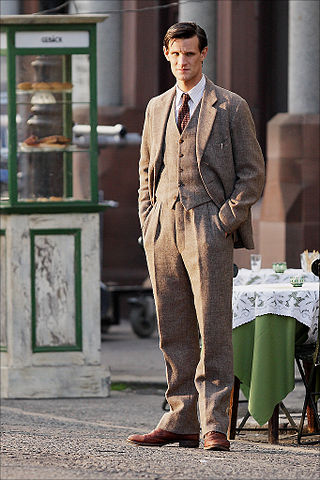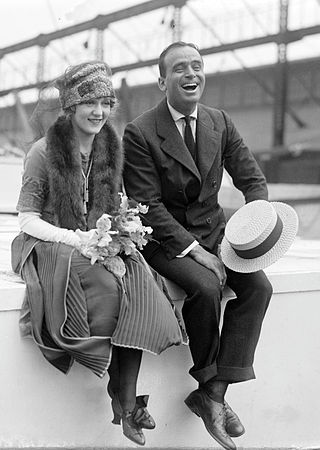
A suit, lounge suit, or business suit is a set of clothes comprising a suit jacket and trousers of identical textiles generally worn with a collared dress shirt, necktie, and dress shoes. A skirt suit is similar, but with a matching skirt instead of trousers. It is currently considered semi-formal wear or business wear in contemporary Western dress codes, however when the suit was originally developed it was considered an informal or more casual option compared to the prevailing clothing standards of aristocrats and businessmen. The lounge suit originated in 19th-century Britain as sportswear and British country clothing, which is why it was seen as more casual than citywear at that time, with the roots of the suit coming from early modern Western Europe formal court or military clothes. After replacing the black frock coat in the early 20th century as regular daywear, a sober one-coloured suit became known as a lounge suit.

Business casual is an ambiguously defined Western dress code that is generally considered casual wear but with smart components of a proper lounge suit from traditional informal wear, adopted for white-collar workplaces. This interpretation typically including dress shirt and trousers, but worn with an odd-coloured blazer or a sports coat instead. Neck ties are optional in this category.

The Official Preppy Handbook (1980) is a satirical reference guide edited by Lisa Birnbach and written by Jonathan Roberts, Carol McD. Wallace, Mason Wiley, and Birnbach. It discusses an aspect of North American culture described as prepdom. In addition to insights on prep school and university life at socially acceptable schools, it illuminates many aspects of the conservative upper middle class, old money WASP society. Topics range from appropriate clothing for social events to choosing the correct college and major.
Clothing terminology comprises the names of individual garments and classes of garments, as well as the specialized vocabularies of the trades that have designed, manufactured, marketed and sold clothing over hundreds of years.

Casual wear is a Western dress code that is relaxed, occasional, spontaneous and suited for everyday use. Casual wear became popular in the Western world following the counterculture of the 1960s. When emphasising casual wear's comfort, it may be referred to as leisurewear or loungewear.

J. Press is a traditional men's clothier founded in 1902 on Yale University's campus in New Haven, Connecticut, by Jacobi Press. The brand also has stores in New York City and Washington, D.C. In 1974, the Press family sold the rights to license J. Press for the Japanese market, making it the first American brand to be licensed in Japan.

Fashion in the 1990s was defined by a return to minimalist fashion, in contrast to the more elaborate and flashy trends of the 1980s. One notable shift was the mainstream adoption of tattoos, body piercings aside from ear piercing and, to a much lesser extent, other forms of body modification such as branding.

Smart casual is an ambiguously defined Western dress code that is generally considered casual wear but with smart components of a proper lounge suit from traditional informal wear. For men, this interpretation typically includes dress shirt, necktie, trousers, and dress shoes, possibly worn with an odd-coloured blazer or a sports coat.

Fashion of the 1980s was characterized by a rejection of 1970s fashion. Punk fashion began as a reaction against both the hippie movement of the past decades and the materialist values of the current decade. The first half of the decade was relatively tame in comparison to the second half, which was when apparel became very bright and vivid in appearance.

The fashion of the 2000's is often described as a global mash up, where trends saw the fusion of vintage styles, global and ethnic clothing, as well as the fashions of numerous music-based subcultures. Hip-hop fashion generally was the most popular among young people of both sexes, followed by the retro inspired indie look later in the decade.

Fashion in the years following World War II is characterized by the resurgence of haute couture after the austerity of the war years. Square shoulders and short skirts were replaced by the soft femininity of Christian Dior's "New Look" silhouette, with its sweeping longer skirts, fitted waist, and rounded shoulders, which in turn gave way to an unfitted, structural look in the later 1950s.

Western fashion in the 1920s underwent a modernization. For women, fashion had continued to change away from the extravagant and restrictive styles of the Victorian and Edwardian periods, and towards looser clothing which revealed more of the arms and legs, that had begun at least a decade prior with the rising of hemlines to the ankle and the movement from the S-bend corset to the columnar silhouette of the 1910s. Men also began to wear less formal daily attire and athletic clothing or 'Sportswear' became a part of mainstream fashion for the first time.

Fashion in the period 1900–1909 in the Western world continued the severe, long and elegant lines of the late 1890s. Tall, stiff collars characterize the period, as do women's broad hats and full "Gibson Girl" hairstyles. A new, columnar silhouette introduced by the couturiers of Paris late in the decade signaled the approaching abandonment of the corset as an indispensable garment.

Ivy League is a style of men's dress, popular during the late 1950s in the Northeastern United States, and said to have originated on college campuses, particularly those of the Ivy League. It was the predecessor to the preppy style of dress.
The United States is the leading country in the fashion design industry, followed by France, Italy, the United Kingdom, Germany, and Japan. Apart from professional business attire, American fashion is eclectic and predominantly informal. While Americans' diverse cultural roots are reflected in their clothing, particularly those of recent immigrants, cowboy hats, boots, jeans, and leather motorcycle jackets are emblematic of specifically American styles.
A man's suit of clothes, in the sense of a lounge or business or office suit, is a set of garments which are crafted from the same cloth. This article discusses the history of the lounge suit, often called a business suit when featuring dark colors and a conservative cut.

The 2010s were defined by hipster fashion, athleisure, a revival of austerity-era period pieces and alternative fashions, swag-inspired outfits, 1980s-style neon streetwear, and unisex 1990s-style elements influenced by grunge and skater fashions. The later years of the decade witnessed the growing importance in the western world of social media influencers paid to promote fast fashion brands on Pinterest and Instagram.

Fashion and clothing in the Philippines refers to the way the people of the Philippine society generally dress up at home, at work, travelling and during special occasions.

British country clothing or English country clothing is the traditional attire worn by men and women in rural Britain; it is the choice of clothing when taking part in outdoor sports such as equestrian pursuits, shooting or fishing and during general outdoor activity, such as walking, picnicking, or gardening. It is also worn at events such as horse races, country weddings, beer festivals and country fairs.

The fashions of the 2020s represent a departure from 2010s fashion and feature a nostalgia for older aesthetics. They have been largely inspired by styles of the late 1990s to mid-2000s, 1980s, and late 1960s to early 1970s Early in the decade, several publications noted the shortened trend and nostalgia cycle in 2020s fashion. Fashion was also shaped by the COVID-19 pandemic, which had a major impact on the fashion industry, and led to shifting retail and consumer trends.

















